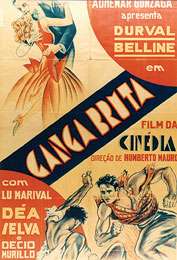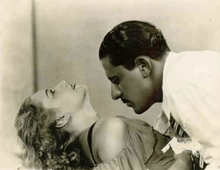Ganga Bruta
Ganga Bruta (literally translated as "Brutal Gang";[1] also known as Rough Diamond[2][3]) is a 1933 Brazilian drama film directed by Humberto Mauro. Starring Durval Bellini and Déa Selva, it follows a man who, after killing his wife on their wedding night, moves to a city where he becomes part of a love triangle. It was produced between 1931 and 1932 for Adhemar Gonzaga at his studio Cinédia.
| Ganga Bruta | |
|---|---|
 Theatrical release poster | |
| Directed by | Humberto Mauro |
| Produced by | Adhemar Gonzaga |
| Written by |
|
| Starring |
|
| Music by | Radamés Gnattali |
| Cinematography | Afrodísio Pereira de Castro Paulo Morano |
| Edited by | Humberto Mauro |
Production company | |
| Distributed by | Cinédia |
Release date |
|
Running time | 82 minutes |
| Country | Brazil |
| Language | Portuguese |
On its initial release, the film was highly criticized and its poor viewing figures resulted in financial losses for the distribution company, but later critics and film directors expressed praise for it. Cinema Novo's Glauber Rocha considered it to be one the best Brazilian films of all time, a title that would be recognized by the Brazilian Film Critics Association in 2015.
Plot
Marcos, a rich engineer, discovers on his wedding night that his bride was not a virgin and murders her in the bridal chamber. Despite the sensation caused in the media by the resultant case, Marcos is acquitted and moves to Guaraíba in an attempt to put the affair behind him. He finds a job managing the construction of a factory and becomes a co-worker of Décio, who lives with his paralyzed mother and Sônia, his adoptive sister. Sônia, who is engaged to Décio, is attracted to Marcos and although he is initially unaware of her feelings, he eventually acknowledges that he has fallen in love with her. After discovering that Marcos has seduced Sônia, Décio swears to kill him, but a fight culminates in Décio's death instead. At the end of the film, Marcos and Sônia get married.
Cast
- Durval Bellini as Marcos
- Déa Selva as Sônia
- Lu Marival as Marcos' wife
- Décio Murillo as Décio
- Andréa Duarte as Décio's mother
- Alfredo Nunes as butler
- Ivan Villar as servant
Production

The film was initially called Dança das Chamas (lit. "Dance of Flames"). Raul Schnoor, Tamar Moema, and Ruth Gentil were planned to take starring roles, with shooting taking place in Amazonas and Pará.[4][5] The film was eventually shot with a different cast in Ilha das Cobras and Quinta da Boa Vista, in the city of Rio de Janeiro, and in Guaxindiba, São Gonçalo, Rio de Janeiro between September 2, 1931 and October 21, 1932, using a hand-held camera.[6][4]
Ganga Bruta was the sixth feature film directed by Humberto Mauro and his second for film studio Cinédia, a company owned by Adhemar Gonzaga.[7] Gonzaga, who was the film producer, conceived it as a silent film with a score recorded on disk and synchronized to the film during its exhibition.[8] When it was almost finished, however, Gonzaga agreed to adding voices recorded on Vitaphone,[8] a change prompted by the advent of sound films and their rise in popularity in the Brazilian market during the production of the film.[6][8]
Reception and analysis
The film was first released on May 29, 1933 in the Alhambra cinema in Rio de Janeiro.[4][5] It was not well received on its release; Ganga Bruta was labeled "the worst film of all time" by critics[9] and resulted in "huge financial losses" for Cinédia.[10] Time Out Rio de Janeiro stated that "It was roundly rejected by traditional critics and short-sighted viewers."[11] Opinions were revised after its restoration in 1952 for a screening at the 1st Brazilian Cinema Retrospective,[9] when it "deeply impressed" the directors who would be part of Cinema Novo movement in the 1960s and 1970s.[1] For example, Glauber Rocha was especially impressed and later cited it as "one of the 20 best films of all time" in his book Revisão Crítica do Cinema Brasileiro.[9] Another film director, Walter Lima Jr., declared, "there are two films that are such clear archetypes of Brazil's eternal quest, namely Limite and Ganga Bruta. They represent something that you have to polish and something that determines its own space, suggesting at the same time that something more exists beyond its confines."[3] In 2015 it would be further recognized by the Brazilian Film Critics Association as the 24th best Brazilian film of all time on its Top 100.[12]
Humberto Mauro[6]
Randal Johnson and Robert Stam, writers of Brazilian Cinema, called the film "Mauro's masterpiece", saying that it "creatively melds the cinematic styles of expressionism and Soviet montage".[1] Encyclopedia of Contemporary Latin American and Caribbean Cultures's Daniel Balderston, Mike Gonzalez and Ana M. Lopez wrote that the film is "magisterial", combining lyricism, naturalism and expressionism.[13] Writing in South American Cinema: A Critical Filmography, Peter Rist praised its music, saying "Mauro's audio-visual mélange" has a "full lyrical effect".[7] Georges Sadoul, author of Dictionary of Films, noted that "despite its silly and conventional plot, this [is] Humberto Mauro's best film and a landmark in the history of Brazilian cinema."[14] Sadoul suggested the industrial elements were used as "erotic symbols", and compared a scene to Luis Buñuel's film Él.[14] French critic Jacques Lourcelles asserted the main theme of Ganga Bruta is violence, alongside which is "an atmosphere of both carnal and cosmic eroticism".[15] Writing for the book Le cinéma brésilien, Carlos Roberto de Souza commented that "there are Freudian and surreal echoes" in the film.[16]
References
- Johnson, Randal; Stam, Robert (1995). Brazilian Cinema. Columbia University Press. pp. 25–26. ISBN 9780231102674.
- "Memory of the World: National Cinematic Heritage" (PDF). UNESCO. September 1995. p. 15. Archived (PDF) from the original on July 6, 2014. Retrieved April 30, 2014.
- Nagib, Lúcia (2004). The New Brazilian Cinema. I.B. Tauris. pp. 246–247.
- "Ganga Bruta" (in Portuguese). Cinemateca Brasileira. Archived from the original on July 6, 2014. Retrieved April 30, 2014.
- "Ganga Bruta" (in Portuguese). Cinédia. Archived from the original on 2014-07-08. Retrieved July 8, 2014.
- Shaw, Lisa; Dennison; Stephanie (2014). Brazilian National Cinema. Routledge. pp. 50–51. ISBN 9781134702107.
- Barnard, Timothy; Rist, Peter (2010). South American Cinema: A Critical Filmography, 1915–1994. University of Texas Press. pp. 153–155. ISBN 9780292792104.
- Ramos, Fernão; Miranda, Luiz Felipe (2000). Enciclopédia do cinema brasileiro [Brazilian Cinema Encyclopedia] (in Portuguese). Senac. p. 131. ISBN 9788573590937.
- Galdini, Ana Paula. "Ganga Bruta (1933)". Cinemando (in Portuguese). Archived from the original on January 13, 2004. Retrieved April 30, 2014.
- Dennison, Stephanie (2004). Popular Cinema in Brazil: 1930-2001. Manchester University Press. p. 48. ISBN 9780719064999.
- "Film". Time Out Rio de Janeiro. Time Out Group: 159. 2007. ISBN 9781846700453.
- "Críticos elegem 'Limite', de Mário Peixoto, o melhor filme brasileiro" [Critics choose 'Limite', by Mário Peixoto, as the best Brazilian film]. O Globo. November 26, 2015. Retrieved August 26, 2017.
- Balderston, Daniel; Gonzalez; Mike; Lopez, Ana M. (2014). Encyclopedia of Contemporary Latin American and Caribbean Cultures. Routledge. p. 936. ISBN 9781134788521.
- Sadoul, Georges (1972). Dictionary of Films. University of California Press. p. 123. ISBN 9780520021525.
- Lourcelles, Jacques (1999). Dictionnaire du cinéma – Les films [Dictionary of Cinema – The Films] (in French). Éditions Robert Laffont. ISBN 2221091124.
- Paranaguá, Paulo Antonio; Augusto; Sergio, eds. (1987). Le cinéma brésilien [The Brazilian Cinema] (in French). Centre Georges Pompidou. p. 138. ISBN 9782858503872.
External links
- Ganga Bruta on IMDb